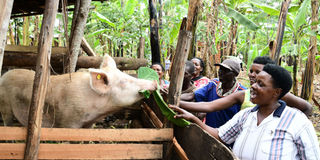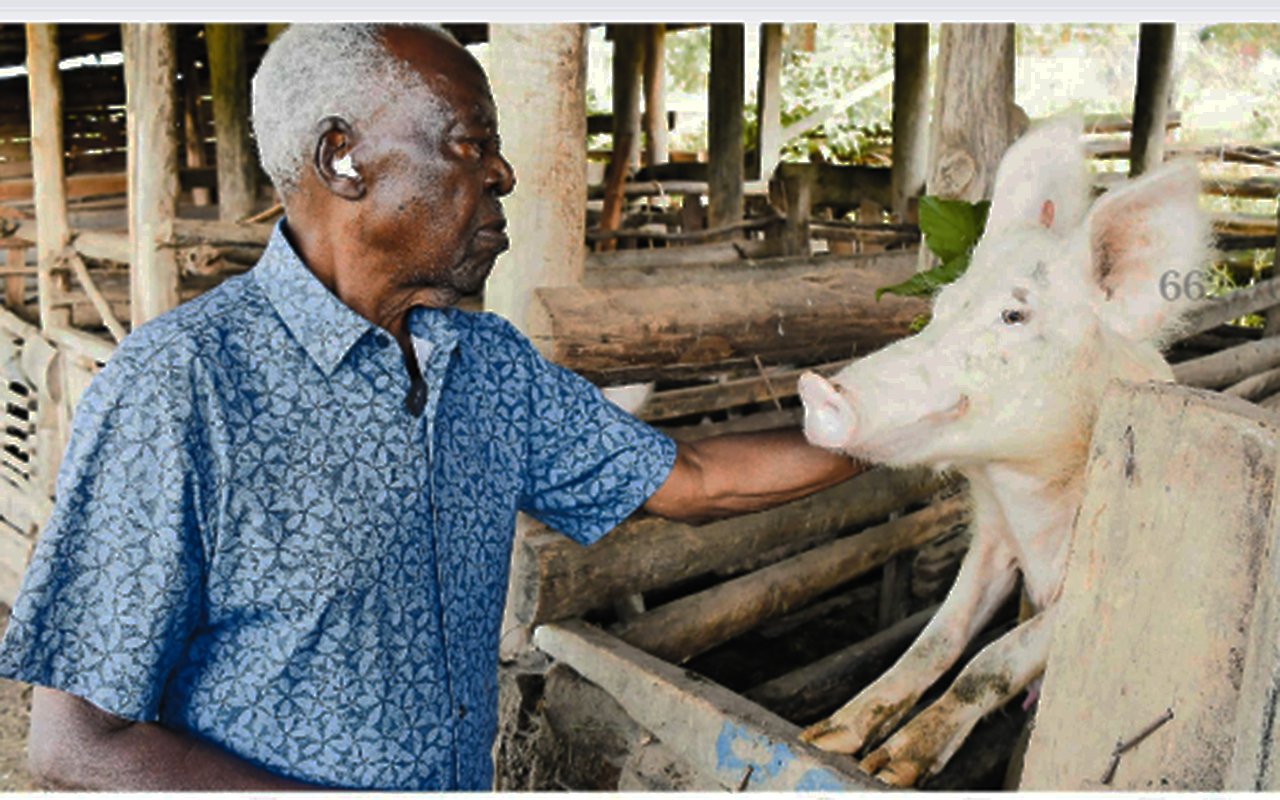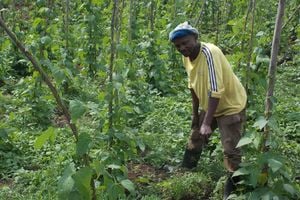
Members of Rwabiruka Bwanda Development Group, one of the many Savings and Credit Cooperatives in Rukungiri that are involved in piggery at their collective farm in Rwabiruka. PHOTO/NMG
As far as the house itself is concerned, it should be well-ventilated, easy to clean and have plenty of sunlight.
Houses for pigs should be designed to ensure optimum growth comfort and prevent dampness.
A farm system used to house pigs depends on the prevailing conditions in that area, as well as the financial situation of the farmer in that area, and this system varies from one place to another.
s far as possible, the housing system should be designed to put as little strain on the land as possible, and it can be either intensive, semi-intensive, or extensive, depending on the land conditions.
Preliminary considerations
The site chosen to dispose of effluents should be well-drained and dry, enabling effluents to be disposed of effectively. Pig buildings are normally built downslope to facilitate the drainage and disposal of effluents. However, this should be avoided if possible. A building should be positioned so that other buildings are not obstructing air flow from the building. A site should be accessible to vehicles, and other transportation means to deliver feeds and animals, pick up pigs to be slaughtered, and dispose of effluent properly at the site.
Buildings must not be located in areas with a high traffic level to minimise noise pollution. Buildings that will be constructed near a good supply of fresh water, clean, and constant should be built on the site.
Low-cost pig house varieties
Pigs need a place to sleep that is warm and protected from the elements. They do not need to be elaborate or large, and pigs like to snuggle up with one another when they sleep and don’t mind being a bit crowded in their shelter.
Barn
A barn with access to an outdoor fencing enclosure is ideal for pigs. Barns are especially beneficial when running a larger farming operation or breeding so that boars can be separated from sows and piglets. Young piglets also need a heated space in the cold winter months.
Straw bale house
Straw bales can be stacked in a brick pattern to create a 3-sided structure in minutes. The straw bales need to be secured with wire fencing or metal t-posts to protect them from the weight of the pig’s bodies. Then it just needs a roof. This can be as simple as placing 2×4’s over the top with a tarp stretched over, or it could be a framed rectangle with metal sheeting attached.
Log cabin
If you have wooded land and ax or chainsaw skills, you don’t need to go to the store to buy materials for your pig’s shelter. Like Lincoln logs, you can build a shelter out of tree trunks/branches by cutting notches on the edges. The logs could also be constructed vertically with a few horizontal pieces attached for stability.
Tunnel house
These structures are shaped like an arch, similar to a greenhouse. They are inexpensive and easy to construct in large quantities. Hog panels can be bent in an arch shape and covered with metal or even a simple tarp for a more temporary structure.
Farrowing house
Farrowing is the process of breeding and birthing a litter of piglets. A farrowing house will contain only sow’s and their litters. Therefore, they must have ample ventilation to heat and cool the structure. The floors should be cement or another material that is easy to clean and disinfect to prevent the spread of disease.
Wooden pen
A wooden pen is among the low-budget pig pens you can make because wood is very accessible. You can find them lying in your home, workshop, or area. For this amazing pigpen, you need two kinds of wood; for the sidewalls, you need bamboo and wood. For the floor, you need stone chips, sand, and cement. However, to keep the floor warm and safe for the pigs, you need additional layers of materials that will cover the surface of the cement.

Overcrowding can lead to stress, which weakens the immune system of pigs and makes them more prone to disease. PHOTO/MONITOR
Size
The number of pigs living in the pigpen should be specified. It is generally recommended that each animal has an area of 8 x 16 feet, although this may vary by breed and the size they reach. Plan for 2-3 more animals than the number in your herd to ensure your animals have enough space.
Materials
Pig pens must be constructed of sturdy materials that are durable enough to withstand their activities. A pig scratched against a fence post, reached through a hole, touched something on the other side, and chewed on any available wood. Wire mesh must be used to cover any wood posts accessible to the pigs so they can’t chew on them. The posts made of metal are generally heavier and more durable than wood, but they are also more expensive.
Shelter
Pigs need a covered, impervious space within the pig pen to stay warm and dry. The shelter doesn’t need to be very tall, four feet is sufficient for most breeds, but the footprint must be spacious enough for all animals to get out of bad weather. The walls of DIY pig pens are typically made of wire mesh, plywood, fiberglass insulation, another plywood layer, and then a final layer of wire mesh.
Food and water access
A top-filling and automatic feeder is the best because it stores large amounts of food but allows only a small amount to be available at a given time. In this way, waste and mess can be avoided. There are also automatic waterers available, but they require water hose connections.
Tip
Advantages Pigs produce valuable nutritious meat by converting inedible feeds, forages, grains from mills, meat byproducts, damaged feeds, and garbage into edible food. Unfortunately, the majority of these feeds are either not edible or not very palatable to humans.




